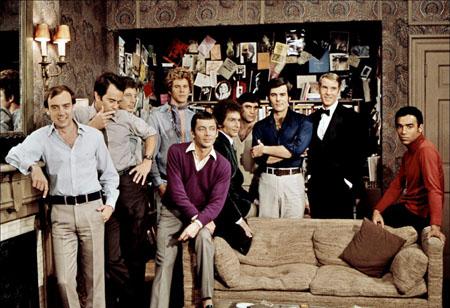When the play The Boys in the Band premiered in New York in January of 1968, North American notions of gay rights, or even gay community, didn’t really exist. Gay people were relegated to the shadows, portrayed in popular culture via subtext or openly only as criminals or victims.
Two years before, though still in his early 30s, playwright Mart Crowley’s career was washed up. Broke and with few professional prospects, he had lapsed into a deep depression.
But after seeing a psychoanalyst – a service paid for by his good friend Natalie Wood – he read a piece in The New York Times by theatre critic Stanley Kaufmann entitled “Homosexual Drama and Its Disguises.” Kaufmann had been on a tear, deriding – without naming – prominent gay playwrights and theatre directors essentially because of their sexualities. He posed the old chestnut argument that gay artists really can’t craft straight characters, that they could only plausibly write openly gay ones. Of course doing so, at that time, meant career suicide. That’s when inspiration struck Crowley. He started scribbling, and five weeks later the script for The Boys in the Band was piled up on his desk.
It is the story of nine gay men together in an apartment, laughing, crying and tearing each other to shreds. Each is glorious, each has demons, and each is laid bare, as by extension is gay life in the late 1960s. It’s a story of human frailty, the costs to the victims of stigma and discrimination, and gay pride.
It was a huge hit, but within two years the world had changed. Like all important works, it was ahead of its time, and the subsequent years were not kind to the playwright or the cast. Crowley struggled with alcohol and lost his way for a time. Not all the original cast members were gay but most struggled to find work and felt rightly that it was because of homophobic stigma. By 1993, five of the nine original cast members had died of AIDS.
Robey’s film chronicles the creation of the play and subsequent film adaptation, the lives of the producers and cast members, and the significant role the story played in the context of the soon-to-burgeon gay liberation movement. Included are extensive interviews with Crowley and many surviving cast members and producers. The film also includes seemingly dozens of familiar faces from the modern US queer set and a healthy dose of fascinating period footage and famous faces.
It is a fascinating look back, 40 years, at a seminal time in the lives of North American gay communities all on its own, but you’ll get the most out of it if you have a chance to see the 1970 film version of The Boys in the Band before you see Making the Boys.
Making the Boys
Sunday, May 22, 4:45pm
TIFF Bell Lightbox
350 King St W
insideout.ca

 Why you can trust Xtra
Why you can trust Xtra


